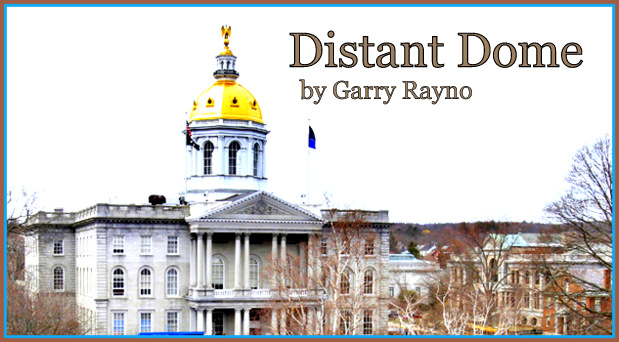
By GARRY RAYNO, Distant Dome
This week the House will take what is usually its most important vote before crossover, House Bill 1 and House Bill 2, or the state’s two-year operating budget for the next biennium beginning July 1.
The budget recommended by the House Finance Committee nearly down party lines on a 14-11 vote, is almost $1 billion more than the current biennial budget, which was actually about the same as the previous biennium’s budget and well below the revenues state taxes produced during the last two years.
So there is room for the budget to grow.
The House proposed budget is also $227 million higher in total spending than the budget Gov. Chris Sununu proposed.
He proposed a $15.47 billion total budget with general fund spending of $6.29 billion, while the House proposed $15.67 billion in total spending and general fund obligations of $6.37 billion.
However as much as they tried and often succeeded in areas, there is no significant bipartisan support for the two-bill package, as Democrats have said they will vote against it unless there is an agreement in several key areas, the repeal of the interest and dividends tax, greater control over the Education Freedom Account program and removing the two-year cap on Medicaid expansion, which the Senate has voted to make permanent.
There are other issues as well including the new education funding formula, Medicaid reimbursement rates, and school building aid and greater support for affordable housing.
While negotiations continue and probably will continue up until Thursday morning, reaching agreement on partisan priorities will be difficult.
Just a reminder that the House is controlled by Republicans by a razor thin margin, but that evaporated last week when a few Republicans joined with Democrats to pass some significant reproductive rights bills, and to kill off other bills that dealt with vaccines or other COVID related issues not to mention the Parental Bill of Rights.
The budget presents its own problems for House leadership as it learned late last week when House Finance Committee member Rep. J.R. Hoell, R-Dunbarton, said he could not support a package that spends as much as the House proposals does.
If anyone thought all the members of the Free State/Libertarian wing of the House were going to back the plan, they do not know what this group is about.
That is why House Speaker Sherman Packard wants as much Democratic support as can be mustered for this budget, just depending on Republican votes for the package was never going to be enough to win approval and send the House blueprint to the Senate.
The budget has many things for Democrats to like such as the 12 percent pay raise for state employees, increased Medicaid reimbursement rates, leaving most of Sununu’s elimination of regulatory and licensing agencies on the cutting room floor, and more money for education funding, but that is not to say there aren’t some critical flaws if you’re a Democrat or a Republican in this budget package.
Let’s start with taxes. The budget package speeds up the elimination of the interest and dividends tax.
The tax was projected to produce $136 million this fiscal year and has produced $52 million through the end of February while more than half of the revenue is produced in the last three months of the fiscal year.
If you are a Democrat, almost all the revenue comes out of the pockets of the top 95 percent of money earners in the state.
If you are a Republican, you want to end the tax as quickly as possible because it is an income tax, so you can say the state has no income tax.
But it is a steady revenue producer, somewhat less volatile than business taxes and where do you make up for the lost revenue, that is what has to be pondered.
Sununu and some Republicans wanted to eliminate the communications tax, which has steadily been going down with the loss of landlines and other aspects of the levy, but it was retained to pay for a change in the retirement benefits for Group II (law enforcement and firefighters) that will cost about $50 million during the biennium.
The biggest tax flaw is the change in the Education Trust Fund, which will receive about $450 million less revenue this biennium with the money going into the general fund instead.
The loss comes from changing the percentage of business profits and enterprise taxes going into the trust fund from 50 percent to 22.5 percent, which the sponsor of the change, House Finance Committee Chair Rep. Ken Weyler, R-Kingston, said would be enough to cover what the fund was originally intended to cover, adequacy grants to school districts and per-pupil grants to charter schools. It also will have to cover the EFA grants, which are projected to increase to $30 million a year for each year of the biennium, which is significantly more than the $24 million that will be spent this biennium.
The change according to the surplus statement from the Legislative Budget Assistant will mean the general fund will have to send about $42.6 million to the trust fund in the second year of the biennium to cover its obligations.
The trust fund used to run an annual deficit but has not for a half dozen years or more and instead has produced surpluses of $250 million or more. With that kind of surplus, some school funding advocates will argue that extra money should go to increasing state aid to public education.
The change moved school building aid, special education, court ordered services and tuition and transportation to regional technical centers from the trust fund to the general fund where they will compete with every other need for money.
The change will also accelerate the time when the EFA program will begin directly competing with public schools including charter schools for trust fund money.
That is when you will see the attempt to drain the public schools of money at the expense of tuition payments to mostly religious, but also private schools that is at the heart of the EFA program.
Another fatal flaw involves the new education funding formula. Supporters said they tried to accelerate the movement of money to poor school districts faster than Sununu’s plan did.
The plan does away with stabilization grants and replaces them with hold-harmless funds that reduce 20 percent a biennium and are less than half the amount of stabilization funding districts received.
The bill increases the extraordinary need grants but does away with fiscal capacity grants that do a much better job of targeting aid to the neediest districts.
The end result is not pretty. For example some of the state’s hardest hit school districts, Berlin, Claremont, Charlestown, Epsom, Erroll, Franklin, Hebron and Pittsfield receive the same amount of money they did this biennium.
Many of those towns are the ones who filed the original Claremont lawsuit.
While those towns are not helped under the new funding plan, Amherst receives an additional $3.3 million over the biennium, Bedford, $7.4 million; Bow, $1.8 million; Exeter, $3.4 million; Londonderry, $4.4 million; Merrimack $5.3 million; Newfields $450,000; Pelham, $3 million; Portsmouth, $400,000; Salem, $6.4 million; Stratham, $2 million, and Windham, $5.2 million.
The biggest cities also do well under the new plan as Concord receives an additional $5.1 million; Dover, $7.5 million; Manchester, $21 million, and Nashua, $17 million.
Some major changes are needed in the formula or there will likely be a third suit pending in the Superior Court system over education funding.
And like two years ago, several controversial bills have found their way into the House budget in House Bill 2.
Two years ago the Senate added the bills to the budget and this year the House decided to do the same thing.
Will the Republicans and Democrats come together and approve a budget Thursday or will it be like 2017 when the House failed to pass a budget and the Senate received almost all it wanted.
And that is the problem for Democrats because the party split is not razor thin in the Senate and is likely to craft a far leaner budget than the House proposes.
Too many things for lawmakers to think about as Thursday nears.
Garry Rayno may be reached at garry.rayno@yahoo.com.
Distant Dome by veteran journalist Garry Rayno explores a broader perspective on the State House and state happenings for InDepthNH.org. Over his three-decade career, Rayno covered the NH State House for the New Hampshire Union Leader and Foster’s Daily Democrat. During his career, his coverage spanned the news spectrum, from local planning, school and select boards, to national issues such as electric industry deregulation and Presidential primaries. Rayno lives with his wife Carolyn in New London.





